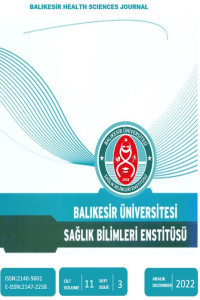COVID-19 Salgını Sürecinde Hemşirelik Mesleğinin Toplumdaki İmajının İncelenmesi: Kesitsel Bir Çalışma
COVID-19, Hemşirelik İmajı, Pandemi, Toplum
Investigating the Image of the Profession of Nursing in the Society in the COVID-19 Pandemic Process: A Cross-Sectional Study
COVID-19, Nursing Image, Pandemic, Society,
___
- Bennett, C. L., James, A. H., & Kelly, D. (2020). Beyond tropes: Towards a new image of nursing in the wake of COVID-19. Journal of Clinical Nursing, 29(15–16), 2753–2755. https://doi.org/10.1111/jocn.15346
- Bozkır, G., Taşcı, N., Altuntaş, Ç., Arsak, A., Balgı, Ö., Kaya, E., Güngör, N., Pekmezci, K., İktu, F., Kavlu, B., & Çelik, S. (2008). Genel lise son sınıf ve sağlık yüksekokulu’ndaki erkek öğrencilerin hemşireliğe bakışı. http://acikerisim.bartin.edu.tr/handle/11772/2834
- Catton, H. (2020). Nursing in the COVID-19 pandemic and beyond: Protecting, saving, supporting and honouring nurses. International Nursing Review, 67(2), 157–159. https://doi.org/10.1111/inr.12593
- Çeli̇k, A. S., Pasi̇nli̇oğlu, T., Kocabeyoğlu, T., & Çeti̇n, S. (2013). Hemşirelik Mesleğinin Toplumdaki İmajının Belirlenmesi. 21(3), 147–153.
- Çevi̇rme, A., & Kurt, A. (2020). Covıd-19 Pandemisi Ve Hemşirelik Mesleğine Yansımaları. Avrasya Sosyal ve Ekonomi Araştırmaları Dergisi, 7(5), 46–52.
- Çınar, Ş., & Demi̇r, Y. (2010). Toplumdaki Hemşirelik İmajı: Bir Ölçek Geliştirme Çalışması. Anadolu Hemşirelik ve Sağlık Bilimleri Dergisi, 12(2), 24–33.
- Degazon, C. E., Ben Natan, M., Shaw, H. K., & Ehrenfeld, M. (2015). Multi-ethnic high school students’ perceptions of nursing in the USA and Israel: A descriptive quantitative study. Nurse Education Today, 35(1), 57–62. https://doi.org/10.1016/j.nedt.2014.05.016
- Di̇nç, S., Kaya, Ö., & Şi̇mşek, Z. (2010). Harran Üniversitesi Sağlık Yüksekokulu Öğrencilerinin Hemşirelik Mesleği Hakkındaki Bilgi, Düşünce Ve Beklentileri. Anadolu Hemşirelik ve Sağlık Bilimleri Dergisi, 10(1), 1–9.
- Eki̇nci̇, M., Di̇ki̇ci̇, İ. C., Derya, M., Andsoy, İ. İ., Di̇nç, S., & Şahi̇n, A. O. (2014). Mühendislik Bölümünde Öğrenim Gören Erkek Öğrencilerin Erkek Hemşirelere Karşı Bakış Açıları. Gümüşhane Üniversitesi Sağlık Bilimleri Dergisi, 3(1), 632–645.
- Elmorshedy, H., AlAmrani, A., Hassan, M. H. A., Fayed, A., & Albrecht, S. A. (2020). Contemporary public image of the nursing profession in Saudi Arabia. BMC Nursing, 19(1), 47. https://doi.org/10.1186/s12912-020-00442-w
- Eski̇mez, Z., Öztunç, G., & Alparslan, N. (2008). Lise Son Sınıfta Okuyan Kız Öğrencilerin Hemşirelik Mesleğine İlişkin Görüşleri. Hacettepe Üniversitesi Hemşirelik Fakültesi Dergisi, 15(1), 58–67.
- International Council of Nurses (ICN). (n.d.). ICN - International Council of Nurses. Retrieved November 11, 2020, from https://www.icn.ch/homepage
- Kalisch, B. J., Begeny, S., & Neumann, S. (2007). The image of the nurse on the internet. Nursing Outlook, 55(4), 182–188. https://doi.org/10.1016/j.outlook.2006.09.002
- Kay M, N. (2015). The image of community nursing: Implications for future student nurse recruitment. British Journal of Community Nursing, 20(1), 12–18. https://doi.org/10.12968/bjcn.2015.20.1.12
- Kızılcık-Özkan, Z., Ünver, S., Avcıbaşı, İ. M., Semerci̇, R., & Yildiz-Findik, Ü. (2017). Bir Grup Hemşirelik Öğrencisinin Mesleğe Yönelik İmaj Algısı. Hemşirelikte Araştırma Geliştirme Dergisi, 19(1), 38–47.
- Özdeli̇kara, A., Boğa, N. M., & Çayan, N. (2015). Hemşirelik Öğrencilerine ve Sağlık Alanı Dışındaki Öğrencilere Göre Hemşirelik İmajı. Düzce Üniversitesi Sağlık Bilimleri Enstitüsü Dergisi, 5(2), 1–5.
- Özdin, S., & Bayrak Özdin, Ş. (2020). Levels and predictors of anxiety, depression and health anxiety during COVID-19 pandemic in Turkish society: The importance of gender. The International Journal of Social Psychiatry, 66(5), 504–511. https://doi.org/10.1177/0020764020927051
- Özpancar, N., Aydın, N., & Akansel, N. (2008). Hemşirelik 1. Sınıf Öğrencilerinin Hemşirelik Mesleği İle İlgili Görüşlerinin Belirlenmesi. 12(3), 9.
- Özsoy, S. A. (2000). Toplumda Hemşirelik İmajının Belirlenmesi. Ege Üniversitesi Hemşirelik Fakültesi Dergisi, 16(2), 1–19.
- Rubbi, I., Cremonini, V., Artioli, G., Lenzini, A., Talenti, I., Caponnetto, V., Cerra, C. L., Petrucci, C., & Lancia, L. (2017). The public perception of nurses. An Italian cross-sectional study. Acta Bio Medica : Atenei Parmensis, 88(Suppl 5), 31–38. https://doi.org/10.23750/abm.v88i5-S.6884
- Takase, M., Maude, P., & Manias, E. (2006). Impact of the perceived public image of nursing on nurses’ work behaviour. Journal of Advanced Nursing, 53(3), 333–343. https://doi.org/10.1111/j.1365-2648.2006.03729.x
- Tan, M., Yuncu, S., Şentürk, Ö., Yildiz, Ö., & Yildiz, Ö. (2010). Üniversite Öğrencilerinin Hemşireliğe Bakış Açıları. Anadolu Hemşirelik ve Sağlık Bilimleri Dergisi, 10(1), 22–29.
- Tortumluoğlu, G., Akyıl, R., Karanlık, A., Aldaç, R., Turaneri̇, E., & Yilmaz, A. (2010). Erzurum İlindeki Bireylerin Hemşireler İle İlgili Görüş Ve Beklentileri. Anadolu Hemşirelik ve Sağlık Bilimleri Dergisi, 8(1), 10–19.
- WHO Coronavirus Disease (COVID-19) Dashboard. (2020). https://covid19.who.int
- Yang, C., Ma, Q. Y., Zheng, Y. H., & Yang, Y. X. (2020). [Transmission routes of 2019-novel coronavirus (2019-nCoV)]. Zhonghua Yu Fang Yi Xue Za Zhi [Chinese Journal of Preventive Medicine], 54(4), 374–377. https://doi.org/10.3760/cma.j.cn112150-20200216-0016
- ISSN: 2146-9601
- Yayın Aralığı: Yılda 3 Sayı
- Başlangıç: 2012
- Yayıncı: Balıkesir Üniversitesi
Ayla SOLMAZ AVCIKURT, Eren ALTUN, Fatma Bahar SUNAY
“Tehlikeli Bölge” Gerçekten Tehlikeli mi?– Endodonik Bakış Açısı
İnfertilite Hikayesi Olan Kadinlarda Anne Bebek Bağlanmasi ve Postpartum Depresyon Arasindaki İlişki
Elif ÖZDEMİR, Sena KAPLAN, Sibel KÜÇÜK
Gülşah AŞIK UYSAL, Mehmet CAN, Emrah ÖZCAN
Ebelik Öğrencilerinin Anatomi Eğitimi Hakkındaki Görüşlerinin Değerlendirilmesi
Emrah ÖZCAN, Esma DERİNÖZ, Ramazan ÇETİN, Aysun ÇELİK, Ömür KARACA, İlter KUŞ
Zeliha BÜYÜKBAYRAM, Meyreme AKSOY
Çocuklarda Aşırı Madde Kayıplı Daimi Molarların Rezin Restorasyonlarının 3 Yıllık Sağ Kalımı
